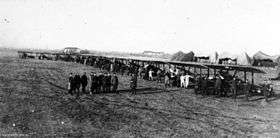Alan Rice-Oxley
| Alan Rice-Oxley | |
|---|---|
| Birth name | Alan Rice Oxley |
| Born |
1 July 1896 Kings Langley, Hertfordshire, England |
| Died | 21 July 1961 (aged 65) |
| Buried at | St Mary Magdalene churchyard, Loders, Dorset, England (50°44′44.8″N 2°43′19.6″W / 50.745778°N 2.722111°WCoordinates: 50°44′44.8″N 2°43′19.6″W / 50.745778°N 2.722111°W) |
| Allegiance | United Kingdom |
| Service/branch |
British Army Royal Air Force |
| Years of service | 1914–1921 |
| Rank | Lieutenant |
| Unit | |
| Battles/wars |
First World War • Western Front • Italian Front |
| Awards | Distinguished Flying Cross |
| Other work |
Police officer, North Borneo Farmer, Dorset |
Lieutenant Alan Rice-Oxley (1 July 1896 – 21 July 1961) was a British pilot during World War I. He became a flying ace in 1918, credited with six aerial victories.[1]
Early life
He was born as Alan Rice Oxley in Kings Langley, Hertfordshire in July 1896.[2] He was educated at Watford Grammar School for Boys, which he attended between January 1908 and July 1914.[3]
Military career

Rice-Oxley first served as a private in the 21st (County of London) Battalion, The London Regiment (1st Surrey Rifles), until 5 February 1915 when he was commissioned as a second lieutenant in the 4th Battalion, The King's (Shropshire Light Infantry).[4]
He was seconded for duty with the Royal Flying Corps,[5] and appointed a flying officer on 10 September 1916.[6] He trained as a pilot and initially served with No. 15 Squadron in France, tasked with artillery-spotting and reconnaissance.[7] He was wounded in action during the Battle of the Somme in October 1916,[8] and after recuperating became a fighter pilot. He was promoted to lieutenant on 1 July 1917.[9] Subsequently, in 1918 he joined the Sopwith Camel equipped No. 45 Squadron on the Italian Front. He recorded his first victories in a combat on 12 July 1918. Piloting Camel D8240, he and Captain Cedric Howell engaged a formation of between ten and fifteen Austro-Hungarian aircraft in proximity to the town of Feltre. In the ensuing dogfight Rice-Oxley destroyed two of the enemy, and for his conduct in this action was awarded the Distinguished Flying Cross.[1] Over the course of the following three days, he destroyed another enemy aircraft and drove a further two down out of control.[7] On 16 August he was appointed a flight commander with the temporary rank of captain,[10] and achieved his sixth and final victory on 22 August.[7]
Rice-Oxley was transferred to the RAF's unemployed list on 26 March 1919,[11] and relinquished his commission in the King's Shropshire Light Infantry on 30 September 1921.[12]
Later life
Rice-Oxley joined the North Borneo Armed Constabulary, attaining the position of Commissioner of Police.[13] On 12 November 1936 he officially changed his name from Alan Rice Oxley to Alan Rice-Oxley by deed poll.[14] From 1942–1945 he was interned by the Japanese as a civilian internee at Batu Lintang camp near Kuching, Sarawak.[13] Post-war, he returned to Britain and was working as a farmer at Uploders, Dorset, when he died on 21 July 1961.[15] He is buried in the churchyard of St. Mary Magdalene, Loders, Dorset.[16]
Honours and awards
- Distinguished Flying Cross
- Lt. Alan Rice-Oxley (Shrops. L.I.).
- "In company with another machine this officer attacked an enemy formation of fifteen aeroplanes, and promptly destroyed two of them. He then repeatedly attacked the remaining thirteen machines, who were crowding on his companion, and the battle ended in the destruction of six of the enemy and one driven down out of control. Two days afterwards he destroyed two more enemy aircraft. The gallantry displayed by this officer, and that of his companion, Capt. C. E. Howell, in attacking fifteen machines, was of the very highest order."[17]
References
- 1 2 "Alan Rice-Oxley". The Aerodrome. 2015. Retrieved 5 December 2015.
- ↑ "Alan Rice-Oxley". National Archives. 2016. Retrieved 19 February 2016.
- ↑ Watford Grammar School (2002), p. 44.
- ↑ The London Gazette: (Supplement) no. 29059. p. 1198. 2 February 1915.
- ↑ The London Gazette: no. 29772. p. 9564. 3 October 1916.
- ↑ The London Gazette: (Supplement) no. 29773. p. 9636. 3 October 1916.
- 1 2 3 Shores, Franks & Guest (1990), p. 319.
- ↑ "The Roll of Honour: Wounded". Flight. VIII (408): 896. 19 October 1916. Retrieved 5 December 2015.
- ↑ The London Gazette: (Supplement) no. 30217. p. 7978. 3 August 1917.
- ↑ The London Gazette: no. 30898. p. 10786. 13 September 1918.
- ↑ The London Gazette: no. 31279. p. 4575. 8 April 1919.
- ↑ The London Gazette: (Supplement) no. 32552. p. 10348. 16 December 1921.
- 1 2 Rosser, Clive; Cresswell, Allan (1 August 2003). "Vale - Sapper Carl Edgar 'Snowy' Jensen WX9682 – 2/6th Field Park Company Royal Australian Engineers" (PDF). The Borneo Bugle. Borneo Prisoners of War Relatives Group. 2 (1): 6. Retrieved 5 December 2015.
- ↑ The London Gazette: no. 34345. p. 7787. 1 December 1936.
- ↑ The London Gazette: no. 42597. p. 1276. 13 February 1962.
- ↑ "Loders, St Mary Magdalene, Churchyard, Dorset, England, Monumental Inscriptions". Dorset Online Parish Clerks. 2015. Retrieved 5 December 2015.
- ↑ The London Gazette: (Supplement) no. 30989. p. 12971. 1 November 1918.
- Bibliography
- Shores, Christopher F.; Franks, Norman & Guest, Russell F. (1990). Above the Trenches: a Complete Record of the Fighter Aces and Units of the British Empire Air Forces 1915–1920. London, UK: Grub Street. ISBN 978-0-948817-19-9.
- Watford Grammar School (2002). A Book of Remembrance 1914–1918. Uckfield, England: Naval and Military Press. ISBN 978-1-84342-424-6.